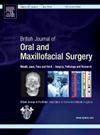Does the application of counter-clockwise rotation in mandibular advancement increase the stress on the inferior alveolar nerve?
IF 1.9
4区 医学
Q3 DENTISTRY, ORAL SURGERY & MEDICINE
British Journal of Oral & Maxillofacial Surgery
Pub Date : 2025-06-01
DOI:10.1016/j.bjoms.2025.03.007
引用次数: 0
Abstract
Sagittal split ramus osteotomy (SSRO) is a reliable surgical procedure for the correction of maxillofacial deformities. However, the most common complication that occurs after the procedure is a neurosensorial disturbance of the inferior alveolar nerve (IAN). Especially in individuals with retrognathic mandible or sleep apnoea, it may be necessary to perform a large amount of mandibular advancement and counter-clockwise (CCW) rotation depending on the angle of the mandibular plane. The likelihood of prolonged neurosensorial disturbance is increased in such patients. The objective of this experimental study was to evaluate the accumulation of stress on the IAN caused by different amounts of advancement and CCW rotation using finite element analysis. The mandibular models with SSRO were advanced 6, 9, and 12 mm and rotated 10 degrees CCW. According to the data obtained, a slight increase in stress values was observed when 10 degrees CCW rotation was applied. However, it was found that significant increases in stress values were directly proportional to the amount of advancement. This experimental study showed that the main cause of stresses on the inferior alveolar nerve after SSRO is the amount of advancement rather than the amount of CCW rotation.
下颌前进时逆时针旋转是否会增加对下牙槽神经的压力?
矢状裂支截骨术是矫正颌面畸形的一种可靠的手术方法。然而,手术后最常见的并发症是下肺泡神经(IAN)的神经感觉障碍。特别是对于下颌后突或睡眠呼吸暂停的患者,可能需要根据下颌平面的角度进行大量的下颌前移和逆时针旋转。这类患者出现长时间神经感觉障碍的可能性增加。本实验研究的目的是利用有限元分析来评估不同的推进量和CCW旋转对IAN造成的应力积累。SSRO下颌模型向前推进6、9、12 mm,旋转10°CCW。根据获得的数据,当施加10度CCW旋转时,观察到应力值略有增加。然而,研究发现,压力值的显著增加与晋升的数量成正比。本实验研究表明,SSRO后下牙槽神经受力的主要原因是移位量而非CCW旋转量。
本文章由计算机程序翻译,如有差异,请以英文原文为准。
求助全文
约1分钟内获得全文
求助全文
来源期刊
CiteScore
3.60
自引率
16.70%
发文量
256
审稿时长
6 months
期刊介绍:
Journal of the British Association of Oral and Maxillofacial Surgeons:
• Leading articles on all aspects of surgery in the oro-facial and head and neck region
• One of the largest circulations of any international journal in this field
• Dedicated to enhancing surgical expertise.

 求助内容:
求助内容: 应助结果提醒方式:
应助结果提醒方式:


